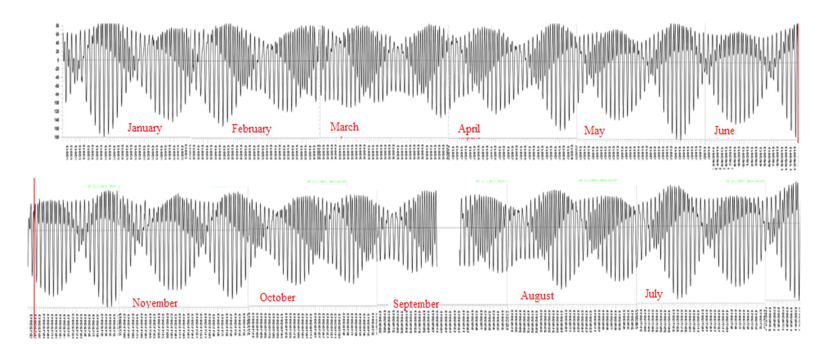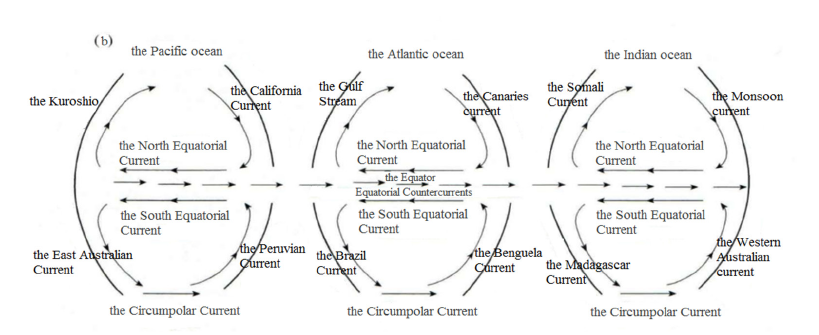- Submissions

Full Text
Research & Development in Material Science
Internal Structure of Planets: The Case of the Earth
Danilov VI*
Institute of Physics of the Earth, Moscow, Russia
*Corresponding author:Danilov VI, Institute of Physics of the Earth, Moscow, Russia
Submission: May 21, 2024;Published: May 28, 2024

ISSN: 2576-8840 Volume 20 Issue 1
Opinion
The humanity has always been fascinated by the structure of the Earth: it all started from the flat form, and further research resulted in acceptance of the sphere form. The recent data allows us to determine the internal structure (model) of the planet according to indirect manifestations and measurement data. This is the topic of this paper.
Explaining the fallacy of the concepts forming the current idea of the planetary structure
It is worth pointing out the postulates that many accept today which, however, have nothing to do with reality:
1. Corilois force, which does not actually exist. This imputed “force” was introduced to describe a body’s behavior during a transition from various observation systems. There is no source of such force in nature. It does not move anything anywhere and does not affect anything.
2. Satellites do not fall on their planets and do not miss the mark. They move along their orbits, where centrifugal forces equal the centripetal forces (gravity). There is no free fall with acceleration, which makes the observed tidal effects possible.
3. There cannot be any convection in the planet’s body.
When such convection is described, the most common example is a heating kettle. But the planet is not a kettle, it is rather a thermos. There cannot be any convection in a thermos: the temperature there, once distributed, does not change its distribution without an external influence. Of course, it would be true only if we ignore the small insignificant losses. If the Sun does not heat the planet, the surface temperature goes below zero, which means that the heat coming from inside the planet is negligibly small.
The illustrations of ascending and descending currents [1,2] do not reflect the reality: ascending streams would not descend if they do not cool down. The ocean does not boil, it does not absorb heat, and the difference between the planet surface temperature and subcrustal temperature is over 3,000 °C. There is no active heat transfer. This thermos is really good and works for millennia. These currents are used to explain generation of the planet’s magnetic field as well as tectonic movements (plumes, jerks, etc.).
Admitting the convection hypothesis as a working one and theorizing based on it, scientists go far from reality and dive into fantasy. At the same time, even if you take the kettle example, the reality is that the kettle boils in the end and the convection gives way to vigorous agitation at the same temperature in the entire mass. For reference, the boiling temperature of iron and silicon dioxide is only 2,800 °C.
In addition, it is worth noting that convection implies a continuous energy inflow. Therefore, there must be an eternal, inexhaustible source of heat! The reality we observe on the planet does not provide such an example.
1. It is dubious to consider a nuclear reaction (the radiogenic hypothesis) to be the source that supports high temperature inside the planet, because lava flowing out of volcanos is weakly radioactive if compared, for example, with radiation in an atomic reactor. Besides, the concentration of radioactive elements in the total mass of the planet is very low. Most of them have low half-life.
Distribution of mass inside the planetary body
Let us consider what object we can take as a prototype of the planet. The famous example of a spherical aquarium suits this purpose quite well. It contains water and various materials with different specific weight, such as rocks, plastic toys, fishes, a feeder, etc. Their distribution is a known thing. If you give it a tilt, a displacement will take place, and if you rotate it, there will be permanent movement with the heavy mass directed towards the Earth. The aquarium always remains in the Earth’s gravity field, just like the Earth remaining in the gravity field of the Sun. So, we can say that the Earth is the same kind of “aquarium” as the Sun. The distribution will be similar: heavy masses will be closer to the Sun, while the most lightweight masses, on the opposite side. Now, if we imagine that the aquarium walls are made of soft rubber-like material, we will be able to simulate the Earth crust behavior under the Sun’s gravity force. If we add water into an inflated balloon, then we can get a visual representation of the Earth crust behavior, the crest and its movement.
It should be noted that the planet is located in the nearequipotential field of the Sun, which means that any part of the Earth gravitates towards the Sun equally. The distance to the Sun is incomparably greater than any distance on the planet.
In fact, the heavy part of matter inside the planet, remaining always on the side of the Sun, moves from East to West and along the North-South spiral, and vice versa, during the displacement of the planet relative to the Sun (season change, variation of the rotation axis inclination angle). The hand of the spiral changes on solstices.
There are two main external sources of gravity, the far and powerful Sun, and the Moon, which is far less massive, but it is close. It means that there are two areas of heavy mass concentration. During the displacement of the Sun, Moon and Earth against each other, these heavy parts of the planet will not only change their positions, but their masses too will be summed up or subtracted. This can be seen on the diagrams of gravity force variation in a certain point (Figure 1). As the heavy mass approaches the measurement point, the Earth’s gravity force increases, while the gravity force of the Sun (or the Moon), which is located above the measurement point at that moment, decreases. That is why we get such complex dependencies of gravity force variation, where we must also consider the season as well as the similar influence of the Moon and its position.
Figure 1:Behavior of gravity forces in 2013, before June 22 and mirrored afterwards. The coastal area of the Sea of Japan.

We can clearly see the nearly perfect match of the values before June 22 and the mirroring afterwards. After the solstice, the mass inside the planet returns with the same daily and monthly dependency to the Southern hemisphere, from where it starts moving backwards after reaching the maximum distance on December 22. Over and over again. A perpetual motion.
Movement of the heavy, positively charged internal mass may be well evidenced by the diagrams given in [3] representing displacement of the zone of natural impulses of the Earth magnetic field. It becomes positively charged because free electrons generated by such temperature conditions “float up”, and the remaining cations and nuclei settle down and form groups in the moving heavy part (an electron is hundreds of times lighter than a nucleus and especially an ion) [4].
Movement of the positively charged mass is similar in its effect to electric current in a conductor. Electric current going from East to West creates the Earth magnetic field, exactly as the one we can observe in reality. Analysis of magnetic fields of other planets confirms the proposed physics [5]..
Movement of masses inside the planet takes place in the area not far from the equator, thus causing the planetary bulge, which makes the Earth a geoid. Gravity forces of the moving masses cause the oceanic water in this area to move, thus creating the main equatorial ocean currents. This also affects the air masses. However, while the continental land prevents the water from cycling around the planet, the aerial masses reaching the stratosphere while being unbound form a loop. The equatorial currents spread out after bumping into the continental land and create all the known currents in the nearly-enclosed basins of the oceans (Figure 2); [6]. Water rise in the western parts of the oceans creates equatorial countercurrents that bring balance.
Figure 2:Conventional illustration (Garetsky [6]) demonstrating the similarity between structures of large currents in the Pacific, Atlantic and Indian oceans.

The same forces induce geotectonic movements, which leads to generation of mountains on continents, just like subglacial water flow in a river generates ice pressure ridges. On the Sun influenced by Jupiter, the same mechanism makes the equatorial part of the Sun turn around at the time different from the poles (differential rotation). A similar effect is observed on Jupiter as well.
When the planetary body cools down, this heavy part stays in the same place. Let us see the Moon as the example. It became a kind of a roly-poly toy. Just like such toy, it always faces the gravity source, the Earth, with the same side making a full rotation in parallel with its full revolution around the Earth. Many satellites in the Solar System behave similarly.
Movement of heavy mass inside the planet takes place at the edge of the Earth crust, near the Moho boundary. Since the path that such mass passes per rotation is quite long, the velocity is high too, more than 1,000km/h according to initial reports. Of course, such movement generates heat in the friction parts, and this is likely to maintain high temperature inside the planet. In fact, we do not observe any other sources of such heating.
Therefore, all the above-mentioned external manifestations of the mass movement inside the planet and measurement data provide conclusive evidence of the proposed model of the planet’s internal structure.
We still have to deal with the conclusions from seismic measurements which laid the foundations for the currently accepted model. Here, we can only assume that the increase of pressure and temperature closer to the center causes transition of the matter to another state, which is high temperature plasma, so physical properties of the matter change [2]. This is exactly what influences the measurements. The rapidly changing processes described above cannot be measured by such methods. You can see the detailed analysis of the processes here [7].
Explaining many natural phenomena with a single, actual, observable, and measurable reason allows us to reduce the number of options (hypotheses) arising around the phenomena in question. A single reason is easier to study in depth based on the diversity of its manifestations.
References
- Iwanami Shoten (1971) Seiya Uyeda Originally published in Japanese, Publischers, Tokyo. Borisov (Ed.), A new look at the Earth. Mir, Moscow, Russia, p. 1980.
- Kirzhnits DA (1971) Extreme states of matter (ultrahigh pressures and temperatures) Successes of physical sciences. Physics of Our Days 104: 489-508.
- Yu P, Malyshkov, C Yu Malyshkov (2009) Periodic variations of geophysical fields and seismicity, their possible connection with the motion of the earth's core. Geology and Geophysics 50(2): 152-172.
- Proshkina ZN, Valitov MG, Kulinich RG, Kolpashchikova TN (2015) Study of tidal variations of gravity in the transition zone from the continent to the sea of Japan (in Russian). Bulletin of kraunts. Earth Sciences 3(27).
- Korotrsev ON (2003) Astronomy St. Petersburg: ABC classics. P. 736.
- Garetsky RG, Dobrolyubov AI (2006) Tidal discrete wave movements and continental drift. Geotectonics 1: 3-13.
- http://geology-vestnik.psu.ru/index.php/geology/article/view/457/362
© 2024 Danilov VI. This is an open access article distributed under the terms of the Creative Commons Attribution License , which permits unrestricted use, distribution, and build upon your work non-commercially.
 a Creative Commons Attribution 4.0 International License. Based on a work at www.crimsonpublishers.com.
Best viewed in
a Creative Commons Attribution 4.0 International License. Based on a work at www.crimsonpublishers.com.
Best viewed in 







.jpg)






























 Editorial Board Registrations
Editorial Board Registrations Submit your Article
Submit your Article Refer a Friend
Refer a Friend Advertise With Us
Advertise With Us
.jpg)






.jpg)














.bmp)
.jpg)
.png)
.jpg)










.jpg)






.png)

.png)



.png)






